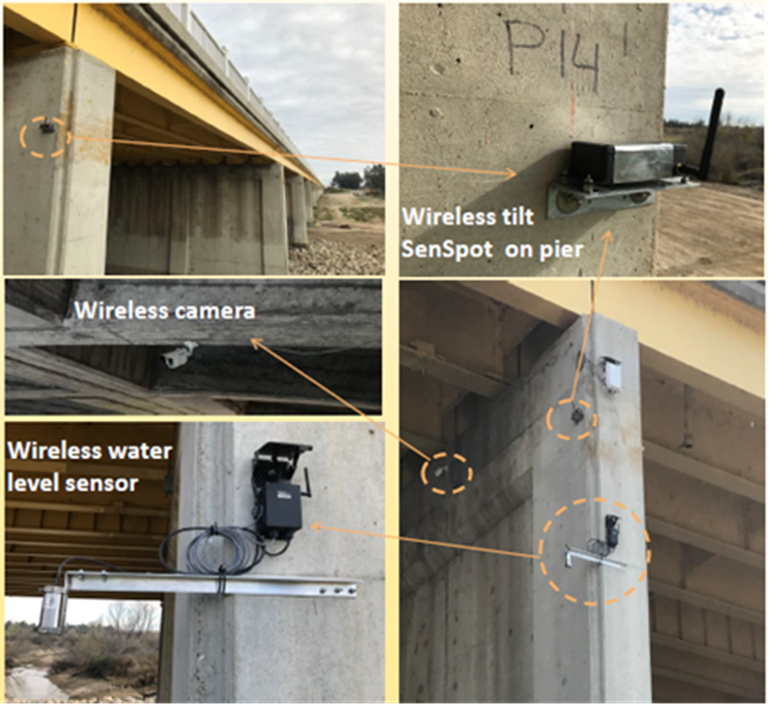Home > Application Notes > Scour Critical Bridges Monitoring
Scour is the engineering term for the erosion of soil surrounding a bridge foundation (piersand abutments). Bridge scour occurs when fast-moving water around a bridge removes sediment from around the bridge foundation, leaving behind scour holes.These holes, in turn, can seriously compromise the bridge’s integrity and result in structural deformation caused by hydraulic damage. Changes in pier orientation (even those as small as 0.00016 degrees) can be an early result and indication of such damage. The ability to monitor movement, settling, deformation and over-tilting of bridges, especially at an early stage, before it becomes a major issue leading to compromise and/or road closure and/or expensive repairs can be important to bridge owners.
According to the Federal Highway Administration (FHWA) scour is the leading bridge failure cause in the United States. According to the National Bridge Failure Database, 58% of bridge failures in the US are due to hydraulic conditions.
Once abridge is evaluated as scour critical, the bridge owner should prepare a scour plan of action to mitigate the known and potential deficiencies. The plan may include installation of countermeasures, monitoring, inspections after floodevents, and procedures for closing bridges if necessary.
Sensing technologies can be put in place for initial scour assessment and also ongoingmonitoring of bridges that have been evaluated as scour critical. The applicable, measurable and monitorable quantities in Scour Critical Bridges are sediment level, tilt/ inclination, water level and ambient temperature/ humidity. Typical applications of scour critical bridge monitoring include stability of foundation (monitor piers abutments, and detect hydraulic damage), decision support (monitor water level, detect flood condition, close bridge during massive floods) and quick structural assessment after major events (quickly detect structural integrity after major distress events for instance; massive floods, hurricanes and earthquake).
Resensys’ unique wireless structural health monitoring solution (SHM) is well-suited for scour monitoring, and Resensys has designed a patentpending instrument, the Wireless Scour Probe, specifically to assist customers with this application .The Wireless Scour Probe SenSpot is installed on bridge piers, and is capable of monitoring sediment location (depth) where the probe is installed. Depending on the situation, this probe information can be combined with sub-arc second accuracy tilt measurements using Wireless High Precision Tilt SenSpot sensors, water level/ flood condition information from the WirelessWater Level Meter SenSpot (Ultrasonic Level Meter SenSpot) and corresponding visual feeds from the Wireless Solar Powered Camera for in-depth and thorough monitoring of the bridge sub structure. This allows completecondition awareness and remote monitoring on scour critical bridges, and is particularly useful to allow quick assessment of conditions after severe floods.
Resensys SenSpot sensors are able to monitor scour-critical quantities inconcrete, steel and composite materials under wet, humid and extreme weather conditions. Resensys products are corrosion resistant and can withstand salty environments.
A Resensys Scour Critical Bridges Monitoring solution comprises Wireless Scour probe SenSpot, Wireless Tilt/Inclination SenSpot, Wireless Solar Powered Cameras and Wireless Water Level Meter SenSpot, to measure and collect the data required for required situation, a SeniMax Gateway to transmit data away from the site and the SenScope display user-interface. (See images below).

Resensys SenSpot sensors are easily placed/ installed on critical elements of scour critical bridge (specific pier, abutment, etc.) as determined by inspection (before or after flood event) or authority’s/client’s suggestion. The Wireless Scour Probe is driven into specific pier from top without need for diverse or complex installation procedures. Since all Resensys sensors are wireless, no additional wiring is required, reducing installation cost and time, providing a cost-effective way for owners to get the data they need. The sensors are mounted with adhesive or flange mounted depending on the application. A Senimax data acquisition unit is conveniently mounted nearby or conveniently mounted within 1.0Km (0.62miles) free space of the Senspot Sensors and a SenScope Module is installed on the client’s/ authority’s laptop or PC.
All system components communicate using cellular or satellite data services, and as a result, the system operates in real time. The system provides an alarm function that allows agencies to react in timely manner, taking precautionary actions and performing subsequent and cost effective remediation, avoiding major or safety-compromising issues. The ultra-low power usage allows short term and long term structural health monitoring.
A complete Resensys SHM system includes software and hardware components for (1) the reliable collection of SenSpot data, (2) aggregation of the data, (3) the addition of timestamps, (4) communication of encrypted data to a remote server, and finally, (5) an interfacefor data visualization and detection of structural issues. Figure below shows a picture of a practical Resensys SHM system. The system includes the following components:
• SenSpot sensors (Wireless Tilt, Wireless Scour, Wireless Water Level and Wireless Solar Powered Camera as required): which are attached to a bridge (A few tens of sensors per structure, depending on design and monitoring needs).
• SeniMax: which collects SenSpot data at the site and sends it to a remote server (one unit can cover as many as 100 SenSpot sensors).
• Repeater: may be used to extend the range of the SenSpot sensors.
• SenScope: software for data analysis and visualization
 More Details
More Details